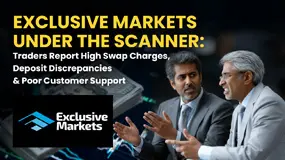简体中文
繁體中文
English
Pусский
日本語
ภาษาไทย
Tiếng Việt
Bahasa Indonesia
Español
हिन्दी
Filippiiniläinen
Français
Deutsch
Português
Türkçe
한국어
العربية
Bad Actor Drained More than 7,500 ETH Out of Uniswap LP Wallets
Abstract:The bad actor targeted over 70,000 ETH wallets, spending over 8 ETH in gas fees. How the phishing attack was carried out, including the technical side and defensive measures.

Hackers are becoming more sophisticated and employ different tactics to deceive investors. A method that is becoming increasingly popular is a malicious airdrop.
Take Advantage of the Biggest Financial Event in London. This year we have expanded to new verticals in Online Trading, Fintech, Digital Assets, Blockchain, and Payments.
Initially, it was believed Uniswap's protocols were exploited. It was later determined that a phishing attack drained approximately $8 million out of Uniswap's liquidity providers.
Uniswap is a popular decentralized exchange (DEX) for Ethereum including tokens on the ETH mainnet.
How the Phishing Attack Starts?
In the first stage, the bad actor hits the explorers index so the 'From' address appears legitimate, 'Uniswap V3: Positions NFT'. This is called an event pollution attack.

Tokens are sent from the bad actor to numerous addresses. Investors that receive the tokens are curious why 'Uniswap' send them tokens. When checking the token's name the investors are led to the following website: uniswaplp.com (do not visit).
The LP that follows Uniswap in the url stands for liquidity provider.
Upon visiting the website, the following message is displayed:
Liquidity provider rewards At 14:00 UTC, July 11, 2022, Uniswap distributed the UniswapLP tokens, based on the provided liquidity, to the existing UNI-V3 liquidity providers.
“If you have received the UniswapLP tokens, then you are eligible to claim the UNI tokens from this page by clicking on the below button.”

As the investors already have received tokens from 'Uniswap' and that only 10k UNI will be airdropped, if claiming is not done immediately there is a risk of the investors missing a portion from the 10,000 UNI.
Employing fear of missing out (FOMO) plays a major role in luring investors into the trap. Upon clicking on the document, a call is made to ethall().
The user's browser info and wallet address are sent to /66312712367123.com.
It may then ask the user to send the tokens to their ETH address. Upon doing so, the bad actor gains full access to the victim's address and drains the account.
The above findings were reported by Harry Denley.
The bad actor sent the 'uniswap' tokens to over 70,000 addresses, spending a substantial amount (over 8 ethers) on gas fees. Among the targeted addresses were large ETH holders.
The vast majority of crypto investors are aware of these scams. However, many are caught off guard if they do not pay full attention to the information in from of them.
The bad actor already commenced laundering the stolen ethers via Tornado Cash, sending 100 ETH per transaction to the mixer.
How to Defend against Similar Attacks?
There are several methods that can be adopted that may reduce the odds of becoming a phishing attack victim in the crypto space. Airdrops must be verified through the project's social media channels.
It may be Twitter, Telegram or Discord etc. If we take a scenario where the project's social media accounts are compromised, which has occurred in the past, paying attention to the permissions that are given upon interacting with the contract including the web address may help.
Another method, which is fairly new is using Forta, which offers real-time security. Forta's threat detection kit may be used for threat detections in NFTs, stablecoins, bridges and more.
ZenGo wallet has a feature called ClearSign that verifies interactions with contracts. As attacks are becoming more sophisticated, it is essential to take the required time to investigate the legitimacy of what you receive including in emails.

Disclaimer:
The views in this article only represent the author's personal views, and do not constitute investment advice on this platform. This platform does not guarantee the accuracy, completeness and timeliness of the information in the article, and will not be liable for any loss caused by the use of or reliance on the information in the article.
Read more

JP Markets Review: High Spread & Commission, Fake Bonus Lure & Withdrawal Hassles Frustrate Traders
Have you been lured into opening a JP Markets Forex Trading Account with a high bonus offer that never existed? Have you found the spread and commission charges higher on JP Markets Login than what’s advertised on the broker’s website? Wondering why you are not able to withdraw funds from your trading account? Well, all of these hint at a potential forex investment scam. Many traders have expressed their disappointment while sharing the JP Markets Review online. In this article, we have shared certain complaints. Take a look at them.

How to Choose A Forex Broker Today
Learn how to choose a Forex Broker with a regulation‑first checklist, fee transparency tips, and risk safeguards to trade with confidence today.

Angel one 2025 Review & Complaints
Angel One is a well-known name in the forex market. People are familiar with the name , but is this broker really worth your interest? What do real users say about Angel One, and what complaints have they shared? In this Angel One 2025 review, you will explore all these details.

Exclusive Markets Under the Scanner: Traders Report High Swap Charges, Deposit Discrepancies & More
Is your forex trading account experience at Exclusive Markets far from good? Do you witness high swap fees and daily charges? Does the deposit fail to reflect in your Exclusive Markets Login? Don’t receive adequate response from the customer support official on your trading queries? You are not alone! Traders have already alleged that the forex broker is involved in these activities. In this Exclusive Markets WikiFX review article, we shared some traders’ comments. Read on to know about them.
WikiFX Broker
Latest News
Is Nash Markets Regulated or Risk? Truth About Nash Markets’ License & Withdrawal Issues
Webull Widens Crypto Futures with Coinbase Derivatives
Latest FCA Daily Alerts and Consumer Warnings for 2025
CySEC Blocks Certification Access to Combat Advisor Impersonation
Angel one 2025 Review & Complaints
Exclusive Markets Under the Scanner: Traders Report High Swap Charges, Deposit Discrepancies & More
Pinched By Penny Shortage, US Retailers Beg Congress To Step In
Interactive Brokers Fined for FINRA Market Data Lapses
Amillex Broker Affiliate Program: A Complete Guide to Earning with Referrals
Saxo Bank Japan Expands European Stock Portfolio with UBS, Ferrari, and Other Major Names
Currency Calculator




